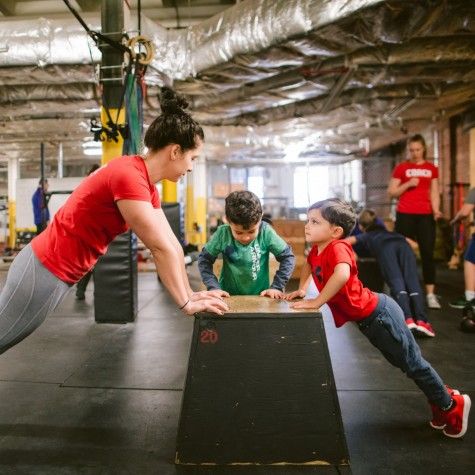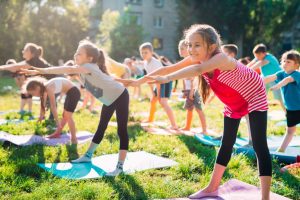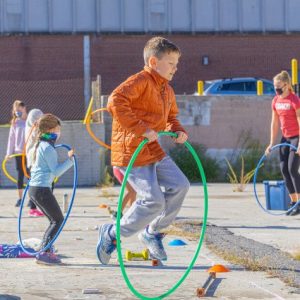With kids, it may already feel like there aren’t enough hours in the day to balance your exercise needs with those of your children.
According to Dr. Christi Hay, founder and pediatrician at Palisades Pediatrics in Washington, D.C., kids need at least an hour of exercise per day. Though recess and playtime count towards this hour, that’s still a big chunk of time where a child needs to be moving their body.
“Good movement impacts good sleep,” Hay says. “Good movement helps in the classroom in terms of expending energy, so that they’re able to focus in class, and…in terms of your physical health, in creating good patterns and attitudes towards movement and exercise.”
While adults may not need to spend as much time being active each day, they still have exercise needs—about 150 minutes per week, according to Centers for Disease Control. The question that emerges then is how to manage those needs with kids bouncing off the walls.
What can kids do while their parents get in their workout at the gym? What can parents and kids do together to make sure everyone gets moving? The good news is there’s plenty of options.

What can kids do at the gym?
Most of the time, gyms don’t permit kids to use workout equipment or free weights. In addition to many gyms not being insured to cover children younger than 18, many don’t have the ability to properly supervise children to make sure they’re using equipment in the appropriate way.
“It’s hard enough to get grown adults to put weights back,” says Brian McGee, head trainer at FIT360DC, a Mount Pleasant-based fitness center. “It’d be much more difficult for children.”
But there’s also no need for children to use equipment to get a good workout. “Developmentally for a kiddo, they don’t need to use any equipment for their health and their movement,” Hay says. Dr. Katie Ryder, a family medicine specialist at Kaiser Permanente, agrees.
“We want kids’ bodies to be strong,” Ryder adds. “But they can do that in their natural play, rather than needing heavy weights to build extra muscle.”
At gyms where children are permitted, designing a workout for your child could mean finding a basketball court or quiet CrossFit room where they can run around. Likely, unless the child is a tween, they will require supervision.
Ryder suggests either letting kids run around or having them take instructions from adults for certain bodyweight exercises, such as pull-ups, push-ups, sit-ups and jumping jacks.
“Things that involve some play or competition, I think, are more engaging for kids: ‘Let me see how fast you can do this activity’; ‘Let me see how fast you can do 10 jumping jacks,’” Ryder says. “It’s also going to keep the kids engaged, focused on what you’re doing and hopefully out of the way, not left to their own curiosity in the gym.”
Some gyms, such as Baltimore’s Push511 Fitness, which specializes in CrossFit, have separate classes and group activities for children which can offer structure while parents are working out.
Baltimore Kettlebell Club offers similar programming, allowing kids to lift weights and use equipment with proper instruction and supervision. Movements such as deadlifts with kettlebells simulate picking up objects, which is a natural inclination for kids, says owner Dan Cenidoza.
“You can even imagine a toddler lifting a pumpkin…Picking things up off of the ground is a very fundamental
movement,” he says.

What about a fun home workout?
If you don’t have access to a gym that allows children or has specific kid-friendly programs, there’s still plenty of ways for kids to get a good workout.
Ardyth Hall, owner of PUSH511 Fitness, suggests that functional movements, which are at the core of CrossFit exercise, can be completed anywhere and simulate exercises completed in day-to-day activities.
“Doing functional movements, you have to engage your whole body basically to do all movements,” she says. “So you’re going to have more compound movements…and that’s life.”
These functional movements, which are appropriate for children because they don’t require special equipment, exercise 10 domains of fitness, according to Hall: accuracy, agility, balance, coordination, flexibility, strength, power, speed, stamina and cardiovascular endurance.
These are big words, but they can really translate to basic movements: running around (speed), jumping over obstacles (agility) or throwing a ball to hit a target (accuracy). With groups of kids on playdates, these activities can be gamified and can look like an obstacle course, races or even playing catch.
These activities can be done anywhere and adapted to accommodate small spaces or furniture available for certain exercises, such as assisted push-ups or tricep dips.
“They can go to the park, they can go to their backyard, they can do it in their living room,” Hall says. “I mean, in COVID, we were all doing stuff in our living room.”
Quanteria Williams-Porche, director of New Orleans -based Split Second Fitness, a fitness center that serves people with disabilities, suggests getting creative with movements for kids who have physical disabilities.
As the mother of a child with cerebral palsy who uses a wheelchair, Williams-Porche takes her son to the park and holds him as he tries to do pull-ups on the monkey bars or pushes against a climbing wall, which can help build good trunk support.
Parents can also purchase resistance bands for their kids to pull to continue to build upper-body strength, depending on the child’s ability.
“We’re just working in different ways to provide some resistance—some strength training for them,” she says.

What can parents and kids do together?
While it’s great to give your kids time and space to use up their energy, you’ll need to build in time to work out, too. If you’re pressed for time, there are plenty of ways to get good exercise side-by-side with your kid.
Functional movement and bodyweight exercises can be easily adapted for difficulty and mobility, says FIT360DC’s McGee.
Kids can do push-ups or assisted push-ups on their knees or on an incline, with their hands on a couch or chair, and parents can do the same, altering the number of push-ups or the speed at which they complete the exercise.
“The faster the exercises, the more you’re going to elevate your heart rate and have it be more of something that’s generally the conditioning part,” McGee says. “Where the tempo is a little slower is going to be more reflective of core and strength.”
The same idea applies to squats or sit-ups. Adults can also add weights or resistance bands at home to add intensity to the workout.
Side-by-side workouts also have another positive consequence for kids, adds PUSH511’s Hall: They get to be inspired by role models prioritizing physical health.
“They [see] their parents consistently coming to the gym,” Hall says. “And they’re like, ‘Well, I want to do that.’”







